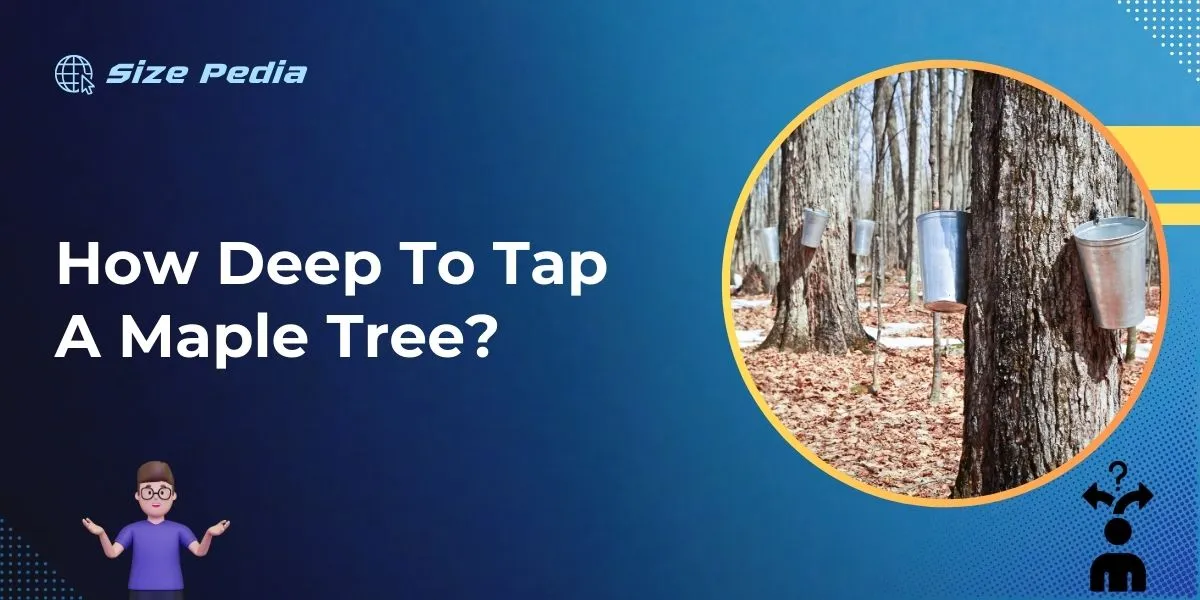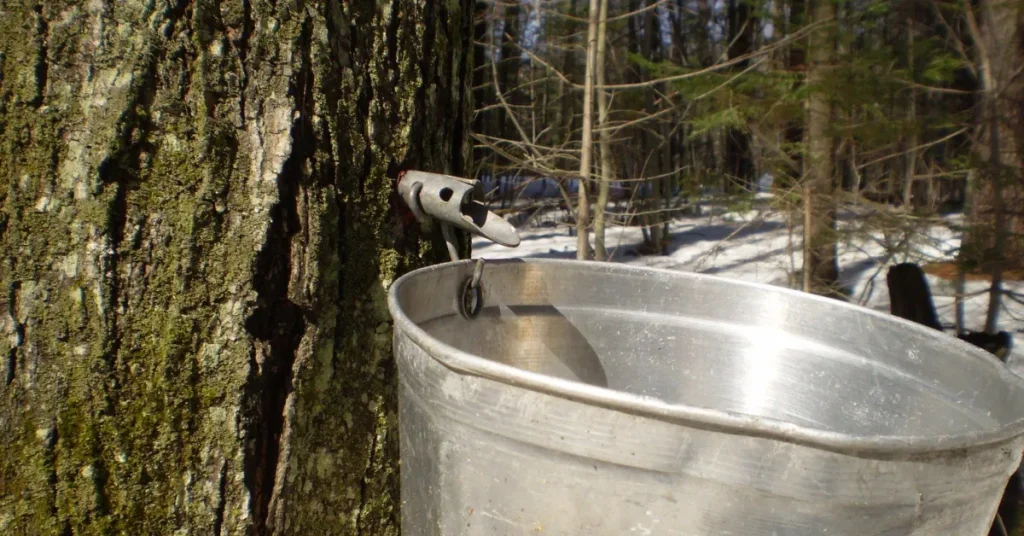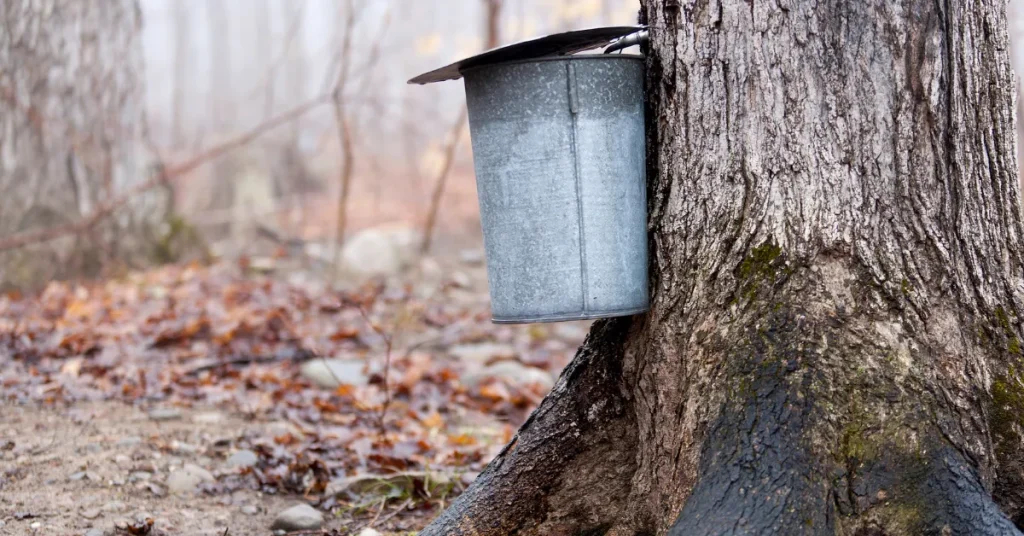For tapping a maple tree, drill a hole about 1.5 to 2 inches deep. Ensure the diameter matches the spout you’re using.
Tapping a maple tree is a quintessential part of early spring in regions with dense maple forests. The tradition of maple tapping, which involves drilling into the tree’s trunk to extract sap, is both a cultural practice and a commercial enterprise.
Maple syrup enthusiasts and producers alike eagerly anticipate the thaw that signals the start of the sap flow. It’s vital for the health of the maple tree that tapping is done correctly and sustainably.
As you prepare to collect this sweet bounty, understanding the appropriate depth for tapping is essential to maximize sap yield while minimizing harm to the tree.
This careful balance maintains tree vitality, guarantees annual sap production, and ensures that forests can continue to provide this natural resource for years to come.

The Sweet Science Of Maple Syrup Production
The Sweet Science of Maple Syrup Production unveils the fascinating journey from tree to table. This natural alchemy involves tapping maple trees to harvest their sap, a practice rich in tradition and careful technique.
Understanding how deep to tap a maple tree is crucial. It ensures the tree’s health and maximizes sap yield, the golden elixir’s source.
Tracing The Maple Syrup Tradition
Maple syrup holds a special place in the culinary traditions of North America. Native Americans first discovered its potential.
They taught early European settlers how to tap these majestic trees. Today, many follow their time-tested methods. Syrup production marks the end of winter and the sweetness of spring.
The Role Of Tree Species In Syrup Quality
Different maple species offer varying sap sweetness levels. The sugar maple, with an average of 2% sugar content, reigns supreme in syrup quality.
Red maples and black maples follow closely. Each species requires a precise tapping depth. This preserves tree health and enhances syrup flavor.
| Species | Average Sugar Content |
| Sugar Maple | 2% |
| Black Maple | 1.7% |
| Red Maple | 1.5% |
The ideal tap depth for a maple tree is 1.5 to 2.5 inches. This range strikes the balance between adequate sap flow and tree preservation.
The diameter of the tree also determines the number of taps it can sustain. Trees with a larger diameter can handle more taps, thus producing more sap for syrup.
- Tree Diameter and Tapping Guidelines:
- 10 to 20 inches in diameter – 1 tap
- 21 to 27 inches in diameter – 2 taps
- Greater than 27 inches in diameter – 3 taps
Following these science-backed guidelines helps maple syrup producers craft a delightful treat. Tapping depth and proper timing ensure the trees remain robust. They also guarantee a bountiful sap harvest. The result is pure maple syrup, a tasty gift from nature’s laboratory.
Identifying The Perfect Maple For Tapping
Spring whispers the sweet call of maple sugaring time. The search for the perfect maple to tap is a sugarmaker’s first step.
Criteria For A Tap-ready Tree
Not all maples are equal. Look for these signs for a tap-ready tree:
- Species: Sugar maples reign supreme, but red, black, and silver maples are also fine.
- Bark: Rough and shaggy on mature trees, smooth on younger ones.
- Branches: High, full crowns indicate a robust tree.
- Trunk Diameter: At least 12 inches across at chest height.
- Environment: Access to sunlight, with ample drainage, is ideal.
Health And Age Considerations
Tree vitality is crucial. Here’s how to judge:
| Age | Health |
| 40+ years for best yields. | No signs of decay like dead branches or fungus. |
| Younger than 10 years is too early to tap. | Check for vibrant leaves in the canopy. |
Assess tree health before tapping. Weak trees may need time to recover.
Timing Is Everything: When To Begin Tapping
Are you eager to capture the essence of spring in a bottle of syrup? Knowing when to tap maple trees is crucial. Your tapping adventure must align with nature’s schedule to harvest the sweet sap.
The Seasonal Sweet Spot
The prime time for tapping trees falls in late winter and early spring. This period is the seasonal sweet spot for syrup producers. It lasts just a few weeks.
Key Points for the Seasonal Sweet Spot:
- Nighttime temperatures need to dip below freezing.
- Daytime temperatures must rise above freezing.
- These conditions cause sap to flow.
Weather Patterns And Sap Flow
The flow of sap doesn’t just depend on the calendar. Weather patterns play a pivotal role. Sap runs best under certain weather conditions.
| Weather Condition | Impact on Sap Flow |
| Frosty Nights | Trigger sap flow |
| Mild Days | Encourage steady sap flow |
| Extended Warm Spells | End the tapping season |
Remember, sap flow is unpredictable. Keep an eye on the local weather for the perfect tapping day.
Mastering The Art Of Mapple Tapping

Learning to tap a maple tree is like dancing with nature. Every step and turn count. It’s a skill that requires precision, care, and the right tools.
Whether you are a seasoned sugar maker or a curious beginner, mastering the art of tapping ensures the health of your trees and the sweetness of your harvest.
Tools Of The Trade
Starting with the right equipment sets you up for success. To tap a maple tree, you will need:
- Drill: A clean, sharp drill bit is critical for a clean hole.
- Spiles: Also known as taps, these direct the sap flow.
- Hammer: A light hammer ensures a snug fit for the spiles without damage.
- Buckets or tubing: These collect your sap cleanly and efficiently.
Drilling Techniques For Maximum Yield
Proper drilling is vital for the tree’s health and maximum sap yield. Follow these steps:
- Choose the spot: Look for a spot on the south side of the tree, about 3 feet from the ground.
- Measure the diameter: Only tap trees that are at least 12 inches in diameter.
- Drill angle: Aim for a slight upward angle to help the sap flow out.
| Tree Diameter (inches) | Number of Taps | Drill Bit Size |
| 12 – 18 | 1 | 5/16 or 7/16 inch |
| 19 – 25 | 2 | 5/16 or 7/16 inch |
| 26+ | 3 | 5/16 or 7/16 inch |
Drill about 2 to 2.5 inches deep. This ensures you reach the sapwood without harming the tree.
After drilling, insert the spile gently with your hammer and hang your bucket. Or, attach your tubing. The sap will start to flow on warm days after cold nights. Now you’re ready to collect the pure, sweet maple sap!
Optimal Depth For Sap Extraction
Tapping a maple tree for sap is a sweet tradition. It gives us delicious syrup. The right depth is key for the best sap flow. This protects the tree too. Learn the secret to the perfect tap depth here.
Determining Tap Depth
Finding the optimal tap depth for sap extraction is crucial. Start with the tree’s diameter. Use a drill and a clean bit. For small trees, 1.5 inches is enough. But for bigger trees, go up to 2.5 inches deep. The goal is to reach the sapwood where the sap flows.
- Measure the tree’s diameter: This tells you how deep to drill.
- Choose the right drill bit: A bit that’s too big or too small isn’t good.
- Check the bark thickness: Thicker bark means deeper drilling.
Avoiding Tree Damage While Tapping
Keeping the maple tree healthy is vital when tapping. Ensuring the correct tapping depth avoids harming the tree. Follow these steps to protect the tree:
- Use sharp tools: This makes clean holes.
- Drill straight: Angled holes can hurt the tree more.
- Don’t tap too deep: It can damage the tree’s core.
Remember, proper tapping lets the tree heal after. Happy trees mean more sap for years to come.
Sustaining Maple Trees For Future Tapping

The lifeblood of a maple syrup operation comes from the health and vitality of maple trees.
Ensuring their longevity is crucial, not just for present-day tapping but for the generations to come. The art of tapping maple trees demands knowledge and respect for the tree’s welfare.
Best Practices For Tree Health
Maintaining robust maple trees is the key to a sustainable tapping future. Adhere to these best practices:
- Select the right trees: Only tap maples with a diameter of at least 12 inches.
- Limit tap numbers: A tree’s size dictates tap quantity—one tap for smaller trees, more for larger ones.
- Clean equipment: Use sterile gear to prevent infection and promote tree health.
- Proper tap placement: Space new taps away from old scars.
When To Remove Taps And Allow Healing
Timing and technique in removing maple sap taps play a critical role in tree recovery. Here is the guidance:
- Monitor sap flow: As it dwindles, prepare for tap removal.
- Remove taps timely: Do this soon after the sap stops flowing.
- Allow natural healing: Trees will form calluses over tap holes.
Treating trees with care during tapping ensures that they remain healthy for future seasons.
FAQs About How Deep To Tap A Maple Tree
How Deep Should You Tap A Maple Tree?
To successfully tap a maple tree, aim for a depth of 1. 5 to 2 inches into the tree. This depth permits you to access the sap without causing excessive harm to the tree.
What Is The Ideal Diameter For Tapping A Maple Tree?
The ideal diameter for a maple tree to be tapped is at least 12 inches at chest height. Trees this size typically indicate they are at least 30-40 years old and can sustain tapping.
When Is The Best Time To Tap A Maple Tree?
The best time to tap a maple tree is late winter to early spring when temperatures fluctuate above and below freezing. This temperature cycle helps sap to flow optimally.
Can You Over-tap A Maple Tree?
Yes, over-tapping can stress a maple tree. Stick to the rule of one tap per 12-18 inch diameter, and never more than 2-3 taps in a mature tree to avoid over-tapping.
Conclusion
Tapping a maple tree is both an art and a science. The ideal depth is roughly 1. 5 to 2. 5 inches, striking a balance between sap flow and tree health.
Remember, the tree’s welfare is paramount. May your syrup endeavors be as sweet as your harvests! Embrace the rhythm of nature, and enjoy the fruits of your careful labor.
Resources:
1. https://mdc.mo.gov/discover-nature/activities/maple-sugaring
